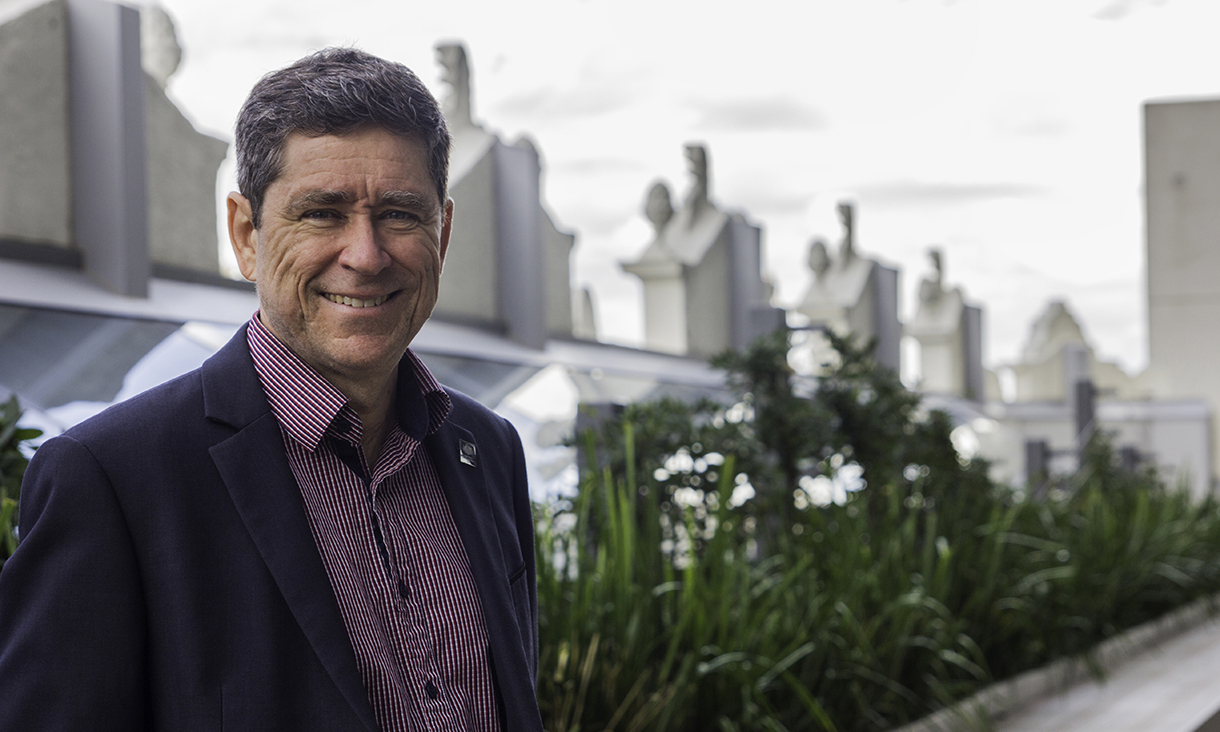Leading astrophysicist receives Swinburne Lifetime Achievement Award

Professor Matthew Bailes has been central to the development of one of the world’s foremost astrophysics and supercomputing centres at Swinburne.
In summary
- Internationally renowned astrophysicist Professor Matthew Bailes has been recognised at the 2020 Swinburne Vice-Chancellor’s Awards with a Lifetime Achievement Award
- Professor Bailes helped establish a leading centre for gravitational wave research at the university
- He also pioneered the use of virtual reality for science and education
Internationally renowned astrophysicist Professor Matthew Bailes has been recognised at the 2020 Swinburne University of Technology Vice-Chancellor’s Awards with a Lifetime Achievement Award.
Professor Bailes has been central to the development of one of the world’s foremost astrophysics and supercomputing centres at Swinburne and has helped establish a leading centre for gravitational wave research at the university.
“Professor Matthew Bailes has been central in putting Swinburne at the cutting-edge of astrophysics,” Swinburne Vice-Chancellor, Professor Pascale Quester says.
“He is also extremely passionate about education and public outreach and has built a team that works to inspire and engage the next generation of scientists.”
Professor Bailes was recruited to Swinburne in 1998 to establish the Centre for Astrophysics and Supercomputing (CAS) research group. He was Director until 2010, overseeing its growth from zero to fifty staff, postdoctoral fellows and PhD students. He also drove the development of Swinburne Astronomy Online.

Professor Bailes pioneered the use of virtual reality for science and education.
“When I was first recruited, the head of my school said; if you come here, you can do anything. And to me, that’s what Swinburne means. It was a place you could do things that were a bit left of field, or out of the textbook,” Professor Bailes says.
He pioneered the use of virtual reality for science and education and was involved in the development of three IMAX films, the first of which, Hidden Universe, was Australia’s sixth-highest grossing documentary within a year of its release.
Professor Bailes also developed supercomputing at Swinburne, designing the first workstation clusters and making them a university-wide and now national resource.

Swinburne’s OzSTAR supercomputer is used by OzGrav in the search for gravitational waves. Its custom paint job, designed by Swinburne graduate Justin Pedler, features gas swirling around two black holes.
Fast radio burst discovery
Professor Bailes’ own research flourished at Swinburne. He has more than 25,000 citations and, together with his former student Duncan Lorimer, discovered a new type of cosmic explosion, called fast radio bursts (FRBs). In 2015 Professor Bailes won an Australian Research Council (ARC) Laureate Fellowship to study FRBs, helping place Swinburne as the leading research centre globally for their future investigation.
In 2015 he was announced as the astronomer leading Australia's role in Breakthrough Listen, a $100 million search for alien life in outer space financed by the late Stephen Hawking and Russian billionaire Yuri Milner.
In 2016 Professor Bailes became the first person to win an ARC Centre of Excellence based at Swinburne for the Centre of Excellence for Gravitational Wave Discovery (OzGrav), which regularly appears in the media for its role in the discovery of sources of gravitational waves.
After leaving the directorship of Astrophysics and Supercomputing Professor Bailes became the Pro Vice-Chancellor (Research) and was twice called upon to act as the Deputy Vice-Chancellor.
From 2021 he will lead Swinburne’s Data Science Research Institute.
-
Media Enquiries
Related articles
-

- University
Update on 131-133 Union Street, Windsor - December 2025
A December 2025 update from Swinburne University of Technology on the property at 131–133 Union Street, Windsor.
Monday 08 December 2025 -

- University
Swinburne launches Australian-first Undergraduate Certificate of Higher Education Studies
Swinburne has launched an Undergraduate Certificate of Higher Education, in an Australian-first that offers a new formal qualification to those who complete tertiary education but fall short of a degree.
Wednesday 10 December 2025 -

- Astronomy
- Technology
- Health
- Science
- University
- Sustainability
- Engineering
Swinburne highly cited researchers reach the top in 12 fields
Ten Swinburne academics have been named on the Highly Cited Researchers 2025 list, released by Clarivate
Tuesday 02 December 2025 -

- University
Over 550 students don caps and gowns to graduate from Children’s University Swinburne
Over 550 students from 34 schools have graduated from Children’s University Swinburne, celebrating over 45,000 hours of learning beyond the classroom this year.
Wednesday 03 December 2025 -

- University
Celebrating excellence at the Vice-Chancellor's Awards
Swinburne’s Vice-Chancellor’s Awards celebrate the ideas and initiatives that demonstrate our values and strategic vision in action.
Friday 12 December 2025

